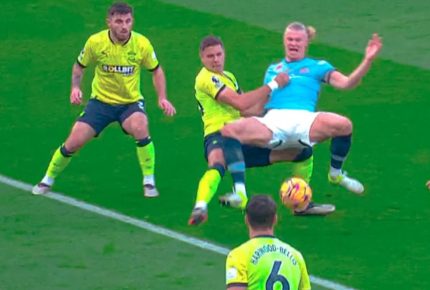Manchester City opened the first half with intensity, signaling their intent early on with Rúben Dias attempting a long-range shot, only to be met with a well-timed save by Southampton’s goalkeeper. Their pressure quickly paid off in the 5th minute, as Matheus Nunes set up Erling Haaland with a cross, which Haaland expertly converted into a goal from the center of the box, giving Manchester City an early 1-0 lead. This early breakthrough was a testament to City’s offensive prowess and Haaland’s instinctive finishing.
Throughout the half, City’s front line maintained relentless pressure, challenging Southampton’s defense and controlling possession. Matheus Nunes and Josko Gvardiol worked in tandem to test Southampton’s defensive line, consistently creating shooting opportunities. Southampton’s defensive unit, however, displayed resilience, particularly through blocks and clearances that prevented City from extending their lead.
Southampton’s Defensive Resilience and Set-Piece Challenges
Despite City’s attacking dominance, Southampton held firm defensively. Taylor Harwood-Bellis and Jack Stephens were instrumental in keeping City at bay, stepping up to intercept and clear balls in high-pressure situations. They managed to win multiple free kicks in the defensive half, which allowed Southampton to reset and temporarily disrupt City’s attacking rhythm. Southampton’s strategy was largely reactive, relying on fouls and set-pieces to relieve the mounting pressure from City’s relentless offense.
City won numerous corners as a result of their continuous pressure, with Southampton conceding five corners in a span of just a few minutes. However, City struggled to capitalize on these set-pieces, often missing the target or being thwarted by Southampton’s defenders. This inability to convert set-piece opportunities highlighted a rare vulnerability in City’s usually clinical execution.
Haaland’s Continued Threat and Key Defensive Interventions by Southampton
As the game progressed, Haaland remained a constant threat, as seen in the 42nd minute when his shot from the center of the box was blocked. Haaland’s presence in the box created constant challenges for Southampton’s backline, forcing defenders like Harwood-Bellis and Manning to make key blocks and interceptions. His aerial prowess was evident as well, particularly in the closing moments of the first half when his header narrowly missed the goal.
Southampton’s resilience under pressure was put to the test again just before the break. Flynn Downes earned a yellow card after a foul on Bernardo Silva, further highlighting Southampton’s defensive struggles against City’s advanced midfielders. Despite conceding multiple attempts on goal, Southampton managed to keep the scoreline close, largely due to their effective positioning and timely clearances.
First-Half Closing Drama and Missed Opportunities
The end of the first half saw Southampton finally break out of City’s stranglehold, with a close attempt by Cameron Archer in added time. Assisted by Jack Stephens, Archer’s left-footed shot nearly changed the game’s momentum as it struck the crossbar, narrowly missing an equalizer. This near miss was Southampton’s best chance of the half and highlighted City’s vulnerability on the counter-attack.
As the whistle blew for halftime, Manchester City led 1-0 but had missed several chances to extend their lead. Despite controlling possession and putting Southampton’s defense under intense pressure, City’s lead remained narrow. Southampton’s defensive approach, albeit passive, had managed to contain City’s attack to a single goal, leaving the match open for a potential second-half comeback. The narrow scoreline suggested that Southampton could still challenge City if they found a way to capitalize on counter-attacking opportunities.
Tactical Substitutions and Fresh Impacts
The second half began with Southampton making a notable substitution as Adam Armstrong replaced Tyler Dibling. Armstrong, known for his dynamic energy, aimed to inject urgency into Southampton’s attack. Just moments into the half, Armstrong’s presence was felt—though not without controversy, as he soon committed a foul on Manchester City’s Matheus Nunes, resulting in a yellow card. This foul set the tone for a highly competitive second half, showing Southampton’s determination to level the score.
Manchester City maintained their composure and responded by organizing their attacks strategically. With the entrance of substitute players and slight adjustments, both teams reshaped their tactics. Armstrong’s contributions, though filled with intensity, often led to fouls that temporarily halted Southampton’s momentum. These substitutions, however, signaled Southampton’s commitment to altering the pace and approach against City’s organized defense.
Manchester City’s Relentless Offensive Push
Manchester City’s offensive drive was relentless as the team sought to widen their narrow lead. Phil Foden and Savinho orchestrated several quick breakaways and set-pieces, continuously pressing Southampton’s defense. In the 50th minute, Erling Haaland’s close-range header was blocked, but City’s aggressive strategy led to multiple attempts, keeping Southampton’s defenders on high alert. Haaland had another close miss in the 52nd minute, highlighting Manchester City’s persistence but also Southampton’s resilience in withstanding this pressure.
Several chances followed with attempts from City’s Savinho, Foden, and Mateo Kovacic, who aimed to exploit any defensive lapses. Despite the repeated attempts, Southampton’s backline and goalkeeper demonstrated impressive defensive efforts, managing to deny City from extending their lead. City’s coordinated attacks and Southampton’s resistance kept spectators engaged, adding intensity to the game’s closing moments.
Southampton’s Missed Opportunities and Defensive Resilience
Southampton’s defense showcased endurance as they blocked multiple shots from City’s offensive players, particularly in the final third. Ryan Manning and Jan Bednarek made crucial interventions that thwarted City’s goal-scoring chances, while Cameron Archer’s efforts occasionally broke through Manchester City’s defense, albeit unsuccessfully. Southampton’s strategy seemed to rely on swift counter-attacks, but numerous offsides and misplaced passes hindered their progress.
Late-game substitutions, including Joe Aribo replacing Adam Lallana and James Bree entering for Ryan Manning, aimed to refresh Southampton’s structure. Aribo’s presence provided Southampton with some much-needed midfield control, but City’s defense effectively neutralized these advances. Southampton’s perseverance was evident, yet the team struggled to capitalize on limited opportunities, allowing City to retain control as the clock wound down.
Closing Minutes and Manchester City’s Strategic Play
As the game reached its final minutes, Manchester City executed a series of substitutions, introducing fresh players like Ilkay Gündogan and later John Stones to stabilize their midfield and defense. Manchester City maintained their composure despite Southampton’s last-ditch efforts, effectively managing the game’s tempo. Erling Haaland’s saved shot in the 90+6 minute underscored City’s continued ambition to solidify their lead until the very end.
Southampton pushed for an equalizer, with Paul Onuachu delivering a strong header saved by City’s goalkeeper. However, City’s defense held firm, ultimately ensuring their narrow victory. The game concluded after 90+8 minutes with Manchester City successfully defending their slim 1-0 lead, showcasing a blend of offensive persistence and defensive solidity that allowed them to secure all three points.














